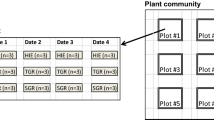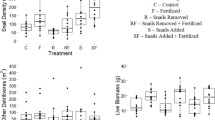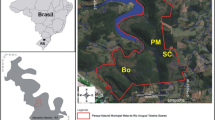Abstract
Detritus based food webs may mediate the impacts of invasive species on ecosystem processes. Holcus lanatus (L.) is an invasive perennial grass that is rapidly spreading in the coastal prairie of California. We used litterbags to determine if H. lanatus altered the rate of litter decomposition through its interaction with the dominant macroinvertebrate detritivore at our study site, the isopod Porcellio scaber (Latreille). Over the course of a year, H. lanatus litter loss was 15% less than annual grasses, a difference that was directly attributable to P. scaber. Although there was no effect of isopods on litter loss during the winter, when most decomposition occurred, isopods had substantial effects on litter loss of annual grasses during the summer. P. scaber had no effect on litter loss of H. lanatus litter. Our findings suggest that H. lanatus invasion slows decomposition in the coastal prairie because it is unusually refractory to an important detritivore. The decreased decomposition of H. lanatus litter, along with increased production during the growing season, lead to a doubling of the end-of-season litter biomass where H. lanatus had invaded.

Similar content being viewed by others
Abbreviations
- BMR:
-
Bodega Marine Reserve
References
Anderson L, DiTomaso J, Hrusa GF, Rejmanek M (1999) The CalEPPC list: exotic pest plants of greatest ecological concern in California. California Invasive Plant Council, Berkeley
Bardgett RD, Mawdsley JL, Edwards S, Hobbs PJ, Rodwell JS, Davies WJ (1999) Plant species and nitrogen effects on soil biological properties of temperate upland grasslands. Funct Ecol 13:650–660
Bardgett RD, Walker LR (2004) Impact of coloniser plant species on the development of decomposer microbial communities following deglaciation. Soil Biol Bioch 36: 555–559
Bodega Ocean Observing Node (2006) http://www.bml.ucdavis.edu/boon/. Cited January 29, 2006
Beal WJ (1887) Grasses of North America. Thorp and Godfrey Printers, Lansing
Cameron GN, Spencer SR (1989) Rapid leaf decay and nutrient release in a Chinese tallow forest. Oecologia 80:222–228
Coleman HM, Levine JM (2007) Mechanisms underlying the impacts of exotic annual grasses in a coastal California meadow. Biol Invasions 9:65–71
Corbin JD, D’Antonio CM (2004) Competition between native and perennial and exotic annual grasses: implications for an historical invasion. Ecology 85:1273–1283
Crossley DAJ, Hoglund MP (1962) A litter bag method for the study of microarthropods inhabiting leaf litter. Ecology 43:571–573
Daniel O, Schönholzer F, Ehlers S, Zeyer J (1997) Microbial conditioning of leaf litter and feeding by the wood-louse Porcellio scaber. Pedobiologia 41:397–401
Davies W (1960) The grass crop, 2nd edn. The Thanet Press, London
Ehler LE (2002) An evaluation of some natural enemies of Nezara viridula in northern California. Biocontrol 47:309–325
Ehrenfeld JG (2003) Effects of exotic plant invasions on soil nutrient cycling processes. Ecosystems 6:503–523
Falconer GJ, Wright JW, Beall HW (1933) The decomposition of certain types of fresh litter under field conditions. Am J Bot 20:196–203
Foster BL, Gross KL (1998) Species richness in a successional grassland: effects of nitrogen enrichment and plant litter. Ecology 79:2593–2602
Fuller TC, McClintock E (1986) Poisonous plants of California. University of California Press, Berkeley
Grayston S, Wang JS, Campbell CD, Edwards AC (1998) Selective influence of plant species on microbial diversity in the rhizosphere. Soil Biol Bioch 30:369–378
Grosholz ED (1993) The influence of habitat heterogeneity on host-pathogen population dynamics. Oecologia 96:347–353
Harding PT, Sutton SL (1985) Woodlice in Britain and Ireland: distribution and habitat. Institute of Terrestrial Ecology, Monks Wood Experimental Station, Abbots Ripton
Harmon ME, Nadelhoffer KJ, Blair JM (1999) Measuring decomposition, nutrient turnover, and stores in plant litter. In: Robertson GP, Coleman DC, Bledsoe CS, Sollins P (eds) Standard soil methods for long-term ecological research. Oxford University Press, Oxford
Hassall M, Rushton SP (1982) The role of copraphagy in the feeding strategies of terrestrial isopods. Oecologia 53:374–381
Heady HF (1988) Valley Grasslands. In: Barbour MG, Major J (eds) Terrestrial vegetation of California, special publication 9. California Native Plant Society, Sacramento
Hendriksen NB (1990) Leaf litter selection by detritivore and geophagous earthworms. Biol Fertility Soils 10:17–21
Hendry GW (1931) The adobe brick as a historical source. Agric History 5:110–127
Jass J, Klausmeier B (2000) Endemics and immigrants: North American terrestrial isopods (Isopoda: Onicidea) north of Mexico. Crustaceana 73:771–779
Kautz G, Topp W (2000) Acquisition of microbial communities and enhanced availability of soil nutrients by the isopod Porcellio scaber (Latr.) (Isopoda: Oniscidea). Biol Fertility Soils 31:102–107
Kourtev PS, Huang WZ, Ehrenfeld JG (1999) Differences in earthworm densities and nitrogen dynamics in soils under exotic and native plant species. Biol Invasions 1:237–245
Kourtev PS, Ehrenfeld JG, Häggblom M (2002) Exotic plant species alter the microbial community structure and function in the soil. Ecology 83:3152–3166
Kotanen PM (2004) Revegetation following soil disturbance and invasion in a Californian meadow: a 10-year history of recovery. Biol Invasions 6:245–254
Lindsay EA, French K (2006) The impact of the weed Chrysanthemoides monilifera spp. rotundata on coastal leaf litter invertebrates. Biol Invasions 8:177–192
Maron JL, Jeffries RL (2001) Restoring enriched grasslands: effects of mowing on species richness, productivity, and nitrogen retention. Ecol Appl 11:1088–1100
Muenscher WC (1951) Poisonous plants of the United States. The Macmallin Company, New York
Nicolai V (1988) Phenolic and mineral content of leaves influences decomposition in European forest ecosystems. Oecologia 75:575–579
Olson JS (1963) Energy storage and the balance of producers and decomposers in ecological systems. Ecology 44:322–331
Paris OH (1963) The ecology of Armadillidium vulgare (Isopoda: Oniscoidea) in California grassland: food, enemies and weather. Ecol Monogr 33:1–22
Paris OH, Sikora A (1965) Radiotracer demonstration of isopod herbivory. Ecology 46:729–734
Peart DR (1989) Species interactions in a successional grassland. III. Effects of canopy gaps, gopher mounds and grazing colonization. J Ecol 77:267–289
Ponge JF (1991) Succession of fungi and fauna during decomposition of needles in a small area of scots pine litter. Plant Soil 138:99–114
Reynolds SA, Corbin JD, D’Antonio CM (2001) The effects of litter and temperature on the germination of native and exotic grasses in a coastal California grassland. Madroño 48:230–235
Richardson H (1905) Monograph on the Isopods of North America. Bull U S Nat Mus 54
Standish RJ (2004) Impact of an invasive clonal herb on epigaeic invertebrates in forest remnants in New Zealand. Biol Conserv 116:49–58
Steel RGD, Torrie JH, Dickey DA (1997) Principles and procedures of statistics, a biometrical approach. McGraw-Hill, Boston
Stöckli H (1990) The discernment of Porcellio scaber (Crustacea: Isopoda) between leaves of the same tree species in dependence of the macroscopically visible colonization by fungi. Pedobiologia 34:191–205
Stromberg MR, Kephart P, Yadon V (2001) Composition, invisibility, and diversity in coastal California grasslands. Madroño 48:236–252
Sutton SL (1972) Woodlice. Ginn and Co., London
Swift MJ, Heal OW, Anderson JM (1979) Decomposition in terrestrial ecosystems. Blackwells, Oxford
Tian G, Brussaard L, Kang BT (1993) Biological effects of plant residues with contrasting chemical compositions under humid tropical conditions: effects on soil fauna. Soil Biol Bioch 25:731–737
Vitousek PM, Walker LR, Whiteaker LD, Mueller-Dombois D, Matson PA (1987) Biological invasion by Myrica faya alters ecosystem development in Hawaii. Science 238:802–804
Vitousek PM (1990) Biological invasions and ecosystem processes: towards an integration of population biology and ecosystem studies. Oikos 57:7–13
Zimmer M, Topp W (2002) The role of copraphagy in nutrient release from feces of phytophagous insects. Soil Biol Bioch 34:1093–1099
Acknowledgements
The National Science Foundation, the Center for Population Biology and the Bodega Marine Lab provided funding for this study. We would like to thank Peter Connors, the reserve manager at the Bodega Marine Reserve, for logistic help and Joyce Havstad for assistance in the field. Meredith Thomsen, Jeff Corbin and Adrianna Muir provided useful insights into Holcus lanatus, and Camille McNeely provided helpful comments on the manuscript. The University of California Natural Reserve System provided a protected field site that made this research possible.
Author information
Authors and Affiliations
Corresponding author
Appendix A
Appendix A
0.006†Rights and permissions
About this article
Cite this article
Bastow, J.L., Preisser, E.L. & Strong, D.R. Holcus lanatus invasion slows decomposition through its interaction with a macroinvertebrate detritivore, Porcellio scaber. Biol Invasions 10, 191–199 (2008). https://doi.org/10.1007/s10530-007-9122-0
Received:
Accepted:
Published:
Issue Date:
DOI: https://doi.org/10.1007/s10530-007-9122-0




